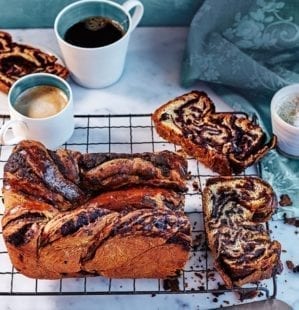
Kouign amann
- Published: 26 Apr 16
- Updated: 18 Mar 24
If, like us, you think a croissant is crying out for more butter then kouign amann is the perfect treat for you. Making these crisp, buttery sugared pastries may be a labour of love but the reward will definitely be worth the challenge. Bake these as the ultimate breakfast treat with which to sweeten up your loved one’s day.

Or, try making these cinnamon, fruit and almond cruffins – a cross between a croissant and a muffin.
-
Makes 16
-
Hands-on 1 hour, oven 25-30 min, plus chilling, rising and proving
Ingredients
- 500g strong white bread flour, plus extra for dusting
- 7g sachet dried fast-action yeast
- 5g fine salt
- 300g warm water
- 60-80g semi-skimmed milk
- 300g Brittany butter (with salt crystals in it), at a temperature that’s pliable without being soft, plus 60g, softened, for greasing
- 150g caster sugar
You’ll also need…
- 1-2 large-hole muffin tins (you’ll need 16 holes)
Method
- Put the flour in a mixing bowl, then stir through the yeast and salt. Mix the water with 60g of the milk in a jug, then pour into the flour, stirring with a palette knife until you get a shaggy, but not wet, dough. You might need the extra 20g milk. Tip out the dough onto a lightly floured surface and knead for 10 minutes or until smooth and elastic. Clean the bowl and lightly grease with a little of the softened butter, then return the dough to it. Cover with cling film or a plastic bag, then leave somewhere warm to rise for around 2 hours or overnight in the fridge.
- Once the dough is puffy and has doubled in size, put the 300g butter between 2 sheets of baking paper and bash with a rolling pin to form a rectangle roughly 25cm x 35cm – it’s easiest to bash it out to a roughly correct shape, then fold the baking paper around it in a rectangle that’s the right size, before rolling the butter to fit perfectly into the rectangle. Tip the dough onto the lightly floured surface again, knead it briefly again to knock out large air bubbles, then roll out to form a rectangle roughly 30cm x 45cm. It will spring back as you roll; just be patient and try to roll rather than stretch the dough.
- Start with one of the short ends of the pastry rectangle facing you. Place the 300g butter in the bottom two thirds of the dough – there should be a small pastry border at the sides. Fold the top third of the dough over the middle third, dust the flour off the exposed side, then fold the bottom, butter-covered third over that, as if you’re folding a letter.
- Turn the dough a quarter-turn to the right, so one open edge is facing you and the other is at the top. Roll out the dough until it has doubled in length, then repeat the rolling-and-folding process – the top third comes down and the bottom third goes up. Neaten the edges to keep them straight using a palette knife or ruler (it doesn’t have to be perfect), then wrap tightly in cling film and chill for 40-60 minutes. Mark how many folds you’ve done on the cling film (it’s 2 at this point).
- Once the dough is chilled and firm, repeat the rolling-and-folding twice more as above. After the fourth roll, sprinkle 100g of the sugar over the dough, trying to leave a 1-2cm border. Fold the pastry like a letter again, then wrap tightly in a new piece of cling film and chill to firm up again. Repeat the roll-and-fold twice more (6 times in total), still keeping the edges neat with a palette knife, then wrap in a new piece of cling film and chill again.
- Once the dough is firm, roll it out into a square, roughly 40cm x 40cm. Use a large, heavy-bladed knife to trim the edges into neat lines, then cut into 16 x 9-10cm squares. Cut the dough by pressing the blade straight down [I], rather than sawing at it – you want to keep the layers intact. You should be able to clearly see the layers of butter in the dough.
- Generously grease the muffin tins with the remaining softened butter (use it all). Brush any excess flour from the tops of the dough squares with a pastry brush, then sprinkle half the remaining sugar over them, patting gently to make it stick. Flip them over, brush and repeat, reserving 2 tbsp sugar. Fold the 4 corners of each dough square into the middle, then push the pastry shapes into the muffin tins so the folded corners are at the top. Cover with a plastic bag or a loose piece of cling film and leave to prove somewhere cool for 45-60 minutes.
- Heat the oven to 200°C/180°C fan/gas 6. Once the kouign amanns have puffed up, sprinkle with the remaining sugar, then bake for 15 minutes. Turn the oven down to 180°C/160°C fan/gas 4 and bake for 10-15 minutes more until the pastries are golden and crisp. Lift them straight out of the tins onto a wire rack, then allow to cool to just warm or room temperature. Enjoy with a coffee or a Breton cider.
- Recipe from March 2016 Issue
Nutrition
Per kouign amann
- Calories
- 318kcals
- Fat
- 18.5g (11.6g saturated)
- Protein
- 3.6g
- Carbohydrates
- 33.8g (9.9g sugars)
- Fibre
- 1.2g
- Salt
- 0.7g
delicious. tips
We’ve measured the liquid by weight rather than volume as it’s more accurate.
We used dried fast-action yeast for ease but if you want to use fresh, crumble and rub 15g of it through the flour before adding the salt.
Be patient! Rushing the rolling and folding of the pastry will cause the layers to merge, forming a dense, tough pastry. Give the dough the full resting time in the fridge; it will make the rolling easier, and ensure the best end results.
If you find that butter is breaking through the layers, pat a generous amount of flour over the exposed bit and carry on. Careful, rather than heavy-handed, rolling will reduce the risk, as will making sure that the underside of the dough is well floured at all times. If necessary, brush off the excess later.
Hold your nerve. If it doesn’t look quite right, don’t assume it’s ruined – chances are it will still look and taste gorgeous.
Start these in the morning to have them ready for teatime. Or make the dough as in step 1, then leave in the fridge to rise overnight. Remove from the fridge 45 minutes before knocking back in step 2. The flavour will be enhanced by this slow rise.
The finished pastries will keep for 1-2 days but are best on the day they’re baked. Warm them through if serving a while after baking.
Buy ingredients online
Rate & review
Rate
Reviews
Subscribe to our magazine
Food stories, skills and tested recipes, straight to your door... Enjoy 5 issues for just £5 with our special introductory offer.
Subscribe
Unleash your inner chef
Looking for inspiration? Receive the latest recipes with our newsletter










